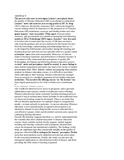Learners’ perception of quality In open and distance education In kenyan public universities

View/
Date
18-04-13Author
Kisimbii, Johnbosco
Type
OtherLanguage
enMetadata
Show full item recordAbstract
The present study aims to investigate Learner’s perceptions about
the quality of Distance Education (DE) in an attempt to understand
Learners’ needs and concerns in assessing quality in DE. As Jung
(2011) observes, the Quality Assurance (QA) criteria developed in
various settings tend to be responsive to the perspectives of Distance
Education (DE) institutions, assessors and funding bodies and often
ignore learners’ views on quality. While inputs from providers,
assessors, and governments are valuable in managing and enhancing
quality in DE as Frydenberg (2002) argues, Learners’ view also need
to be taken into account since the success of DE does not derive
only from the products and services delivered to the learner but also
from the knowledge, understanding and relationships that are`1+
co-developed by both learners and teachers during the teaching and
learning processes and such success typically relies to a greater extent
on learners’ motivation and commitment. Moreover, in order to
improve learning experience and performance of distance learners. It
is essential to fully understand their perceptions of quality DE.
In designing, developing and delivering distance education courses
students’ needs and perceptions should be central. A course failing to
meet student expectations and needs may lead to low levels of student
involvement (Hall, 2001). Indeed, without investigating what satisfies
students in distance education courses, it is difficult to meet their
needs and improve their learning. Distance education has changed
from an anomaly to a standard component of most higher education
institutions. The incentive for offering courses via ‘the distance’ has
been largely pronounced as two-fold: to better serve constituents
24
U o N - I S O 9 0 0 1 : 2 0 0 8 C e r t i fi e d
who would not otherwise have access to programs, and to generate
additional revenue streams outside of traditional course offerings.
Distance education has taken systematic teaching learning process to
persons living in isolated areas where facilities for the traditional form
of classroom teaching cannot be developed. There is no doubt that
DE can broaden opportunities for underprivileged or marginalized
people – women and girls in particular – to access education. Distance
education is now internationally recognized and accepted as an
alternative channel for providing broader access to education in a
cost effective manner, wider and diversified curricula and a means for
continuing lifelong education.
Overall, the literature suggests that there is a need to understand better
the variables that affect student enjoyment of distance education
courses. Such variables include faculty support, student support,
teaching and learning, evaluation and assessment, infrastructure,
course development and institutional credibility. The findings of this
study are important since they can provide insights on the quality of
programs offered by DE according to the learners’ perception. Further
areas that need attention can be identified and relevant action taken
by the concerned institutions. Finally, this study can also provide
managerial implications to educational providers in Kenya, and those
providing the ODL mode of learning in general
URI
http://distance-education.uonbi.ac.ke/sites/default/files/cees/disteducation/disteducation/CONFERENCE%20BOOKLET.pdfhttp://hdl.handle.net/11295/61203
Citation
The Academic Conference In The School Of Continuing And Distance Education Theme:utilization of open and distance learning In addressing educational challenges in Kenya towards fulfilment of the vision 2030Publisher
University of Nairobi School Of Continuing And Distance Education
